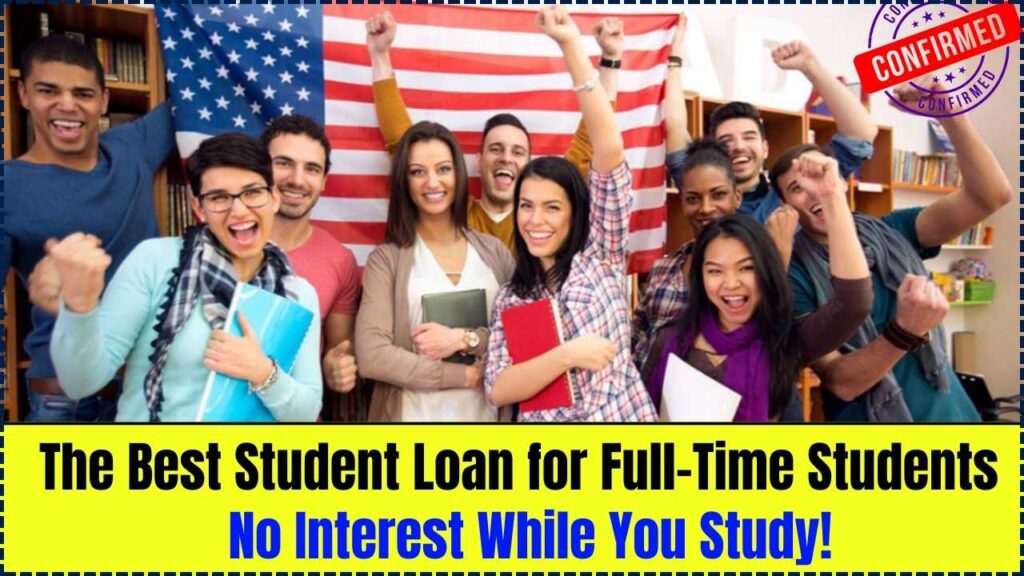
Best Student Loan for Full-Time Students: Paying for college is a major concern for many students and their families. With the rising cost of tuition, housing, and textbooks, taking out a student loan is often a necessity. But not all student loans are created equal. If you’re a full-time student, finding a loan that doesn’t charge interest while you study can save you thousands of dollars.
This guide will explore the best student loans that accrue no interest while you study, how to qualify, and what options are available for students seeking affordable education financing.
Best Student Loan for Full-Time Students
| Feature | Details |
|---|---|
| Best Loan for Full-Time Students | Federal Direct Subsidized Loans |
| Interest While Studying? | No interest accrual while in school |
| Who Qualifies? | Undergraduate students with financial need |
| Loan Limit per Year | $3,500 – $5,500, depending on year in school |
| Repayment Start Date | 6 months after graduation or dropping below half-time status |
| Other No-Interest Options | Nonprofit, state-based, and institutional loans |
| Where to Apply? | Studentaid.gov |
For full-time students looking for the best student loan with no interest while studying, the Federal Direct Subsidized Loan is the top choice. No interest accrues during your studies, making repayment more manageable after graduation.
If you don’t qualify for a subsidized loan, explore nonprofit and state-sponsored zero-interest loan programs to further reduce your financial burden.
Next Steps:
- Submit the FAFSA at Studentaid.gov.
- Research no-interest nonprofit loans.
- Check your state and college’s financial aid office for additional opportunities.
By securing a no-interest loan, you can focus on your education without worrying about interest charges piling up.
1. What Are No-Interest Student Loans?
A no-interest student loan is a loan where interest does not accumulate while you’re in school. This means you only repay the original amount borrowed, rather than a growing balance due to interest charges.
There are two main types of no-interest loans:
- Federal Direct Subsidized Loans – Offered by the U.S. government for undergraduate students with financial need.
- Private and Nonprofit No-Interest Loans – Offered by select nonprofit organizations and universities.
Both options can help minimize student debt and make repayment more manageable after graduation.
2. Federal Direct Subsidized Loans – The Best Option for Full-Time Students
The Federal Direct Subsidized Loan is the best loan for full-time students because:
- No interest accrues while you’re in school (must be enrolled at least half-time).
- The government covers interest while you’re in school and during deferment periods.
- Affordable repayment plans are available after graduation.
Who Qualifies for Federal Direct Subsidized Loans?
- Undergraduate students only
- Must demonstrate financial need
- Must be enrolled at least half-time in an eligible program
- U.S. citizens or eligible noncitizens.
Loan Limits for Direct Subsidized Loans
| Year in School | Annual Loan Limit |
|---|---|
| First-Year Undergraduate | $3,500 |
| Second-Year Undergraduate | $4,500 |
| Third-Year and Beyond | $5,500 |
Where to Apply? Submit the Free Application for Federal Student Aid (FAFSA) at Studentaid.gov.
3. Private & Nonprofit No-Interest Loans
Besides federal loans, some private and nonprofit organizations offer interest-free student loans. These loans typically require demonstrated financial need, a strong academic record, or community service commitments.
Examples of No-Interest Student Loans
- Bill Raskob Foundation – Provides interest-free loans to U.S. citizens for undergraduate study.
- Evalee C. Schwarz Charitable Trust – Offers no-interest loans to academically strong students with financial need.
- Military Officers Association of America (MOAA) – Grants interest-free loans to students whose parents served in the military.
- State-Sponsored No-Interest Loans – Some states offer special zero-interest student loan programs.
Tip: Check with your state’s higher education office or financial aid department for potential no-interest loan programs.
4. Best Student Loan for Full-Time Students Apply for No-Interest Loans
- Submit the FAFSA:
- The FAFSA (Free Application for Federal Student Aid) determines eligibility for Direct Subsidized Loans and other financial aid.
- Apply at Studentaid.gov as early as possible to maximize aid opportunities.
- Research Nonprofit and State-Based Loans:
- Visit nonprofit organizations’ websites to check eligibility and application deadlines.
- Check your college’s financial aid office for institutional loan opportunities.
- Prepare Required Documents:
- Financial aid forms (FAFSA confirmation, tax returns, etc.)
- Proof of academic achievements (GPA, standardized test scores)
- Letters of recommendation (if required for nonprofit loans)
Tip: Some nonprofit loans require an essay or interview as part of the selection process.
FAQs On Best Student Loan for Full-Time Students
1. How long do I have before I need to start repaying my loan?
For Direct Subsidized Loans, repayment begins 6 months after graduation or dropping below half-time enrollment.
2. What happens if I don’t qualify for a no-interest loan?
Consider Direct Unsubsidized Loans, which are available to more students but accrue interest while you’re in school.
3. Can graduate students get no-interest loans?
Federal Direct Subsidized Loans are only for undergraduates, but some nonprofits and universities may offer interest-free loans to graduate students.
4. What’s the difference between subsidized and unsubsidized loans?
- Subsidized Loans: Government pays interest while you’re in school.
- Unsubsidized Loans: Interest accrues while in school and adds to your loan balance.
5. Can international students get no-interest loans?
Most U.S. federal and state-based programs require U.S. citizenship, but some private lenders or nonprofit organizations may offer loans to international students.
6. Are there any repayment benefits for Direct Subsidized Loans?
Yes! Income-driven repayment plans and loan forgiveness programs (like Public Service Loan Forgiveness) can help reduce repayment burdens.








